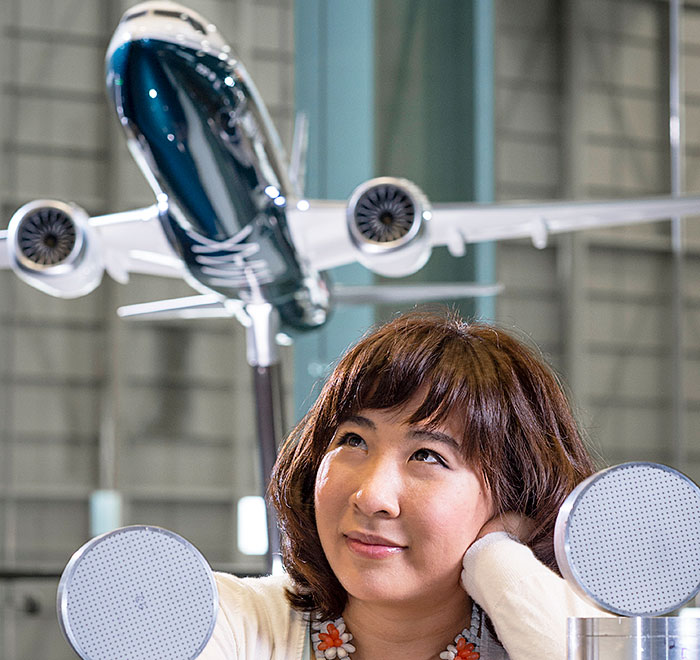You can hear the difference

Acoustics engineer Jackie Wu is part of the team designing quieter engines for the 737 MAX. Improvements include quieter acoustic material displayed in the foreground. (Boeing photo)
Jackie Wu brings a creative background with a fondness for music to her work in acoustics engineering, which she sees as a form of art. “Acoustics is something that you can’t see or touch, but like music it can influence how it makes people feel,” said Wu, an engine acoustics engineer on the 737 MAX, the newest member of Boeing’s single-aisle family of aircraft now in development.
“It‘s a good feeling to know people will be able to hear the difference in the advanced engine system we’re developing for the 737 MAX.”
The new engines, manufactured by CFM International, will include a variety of noise-reduction technologies. Wu’s focus is the acoustic inlet, which is the front part of the large housing called a nacelle around the engine. The inlet conditions the airflow and includes a perforated lining on the engine’s inner wall.
“Air flows into the front of the engine and passes through the fan blades and other high-speed engine parts, which produce a lot of noise,” Wu explained. “We want to maximize the inlet’s acoustic treatment so it acts kind of like a muffler, reducing the noise before it can leave the engine housing.”
The acoustics research starts with analytical tools, acoustics theory and the experience gained from flight tests and products already in use. “My group knows this type of inlet works well and the general noise reduction we should be able to expect,” Wu said. “We scale the past research to fit the new engine and reach the final design, adding new knowledge along the way.”
Wu’s team then develops the engineering and geometric requirements that will guide the inlet’s manufacture. Noise-reduction technology is also applied to the thrust reverser and chevrons, the signature wavy section at the exit of the nacelle. “The new technology is quite different from the Next-Generation 737. The noise improvements over the current generation of engines will be substantial,” Wu said.
The 40 percent smaller community noise footprint is expected to be welcome news for Boeing customers and people living near busy airports. “Airlines face stricter noise regulations at airports around the world, especially in densely populated areas,” Wu said.
Wu’s team will continue its work until the first major test of the new engine before the airplane’s entry into service. “We will hang a single engine on a huge test fixture and set up microphones all around it,” Wu explained.
“The engine is run through its full performance range and we measure the noise. That’s when we see how it compares to what we have been predicting.”
Boeing and CFM engineers then continue engine development and refinement until the official certification process, which includes static and flight tests, leading up to airplane delivery in 2017.
Wu enjoys every step of the long and sometimes complicated process. “It’s the combination of planning, design and seeing it all come together in a finished product that is really cool for me,” Wu said. “You can actually hear the difference. I feel good that Boeing is committed to finding new ways to shrink our aircrafts’ noise and environmental footprint.”

